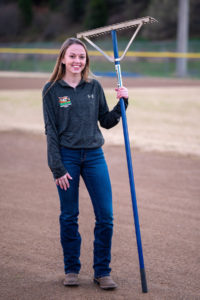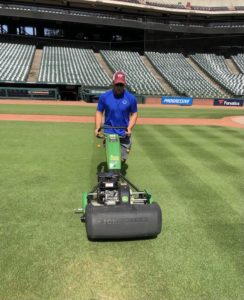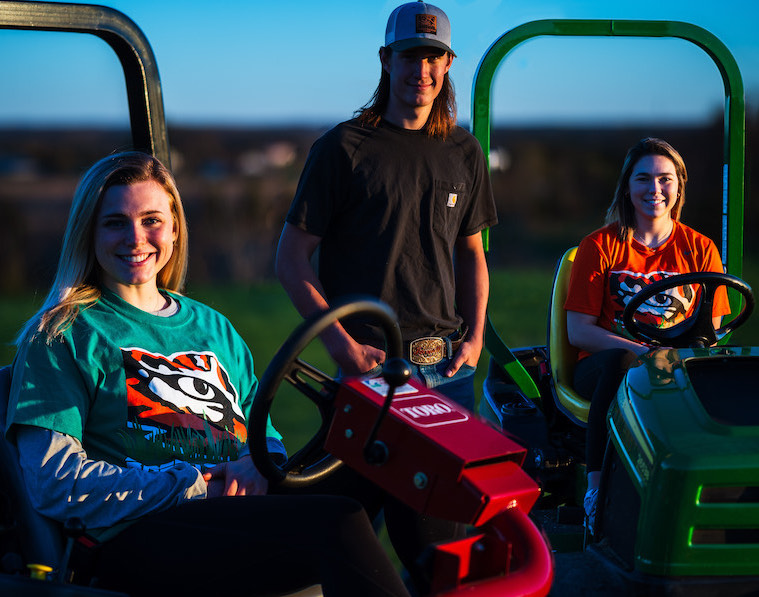By Drew Miller
Sports field management is spread far and wide from different local recreation levels to the professional stage. But who are the individuals that will continue all of the incredible work sports field managers do every day? And where will they come from?
Dr. Sandor and I have seen collegiate and high school turfgrass management programs full of prospective future industry leaders. As educators, we have learned and discovered new and creative ways to promote the sports field management industry to America’s younger generation. It is critical for sports field managers and STMA members to promote this incredible industry to the youth in their communities.
Sports field managers play such a significant role in their communities, as they are maintaining multiple playing surfaces on which millions of athletes play the sports they love. As an industry, we help create memories for athletes and fans throughout the country – from watching or playing Little League baseball games to attending or playing professional sports. We have the opportunity to bring our life’s work to light through outreach in our local communities. As STMA members – and especially Certified Sports Field Managers and those working toward certification – we also have the opportunity to provide athletes, coaches, administrators and parents the assurance and peace of mind that we are trained and educated professionals who work to ensure the playing fields are not solely picturesque, but, most importantly, playable and safe for all involved. In the past, our industry has had trouble finding young, experienced and passionate workers who can join the next generation of sports field managers. Some issues we have seen throughout the years relate to the recruitment and retention of young industry workers. We must all take seriously the importance of finding the next generation of industry leaders to ensure and maintain a positive outlook on the sports field management industry’s future.

Growing up, many individuals play sports and dream of a professional career as a player. Because their focus is on playing, they never notice the things that add to their love of the game – the field kept in shape so they are not injured, mowed-in patterns that are pleasing to the eye, etc. It is our job to have them take notice of the things around them. Let them see that they can have a professional career in baseball as a groundskeeper rather than as a player. When I went to see the Mets play as a child, I was far more excited by Mike Piazza than the New York cityscape striped into the field. In my youth, I noticed the work of the Hall of Fame catcher. Our job is to make the youth notice the work of the Hall of Fame groundskeeper, Pete Flynn!
Look back on your career and think about what brought you to the sports field management industry. What was that experience? Did you hear from a friend? Why did you choose this career path, and how did your passion for the industry grow? As industry professionals, we must provide the young individuals in our communities the opportunities to find us and become the next generation that will carry on the work. We have all had mentors who gave us the chance to become a part of the sports field management industry. I was never the most qualified or most skilled worker, but industry leaders provided me the opportunity to pursue what I was passionate about. We must all have the patience to give that chance to young individuals so that they may discover their interests, and allow them to grow.
There are various strategies to promote the sports field management industry, beginning with the visibility of the Sports Turf Managers Association (STMA) through signage, banners, branded apparel and other tools and accessories at and around facilities that advertise and exemplify the industry to untrained eyes. How many athletes, parents, coaches and administrators do you think even know there is a Sports Turf Managers Association? Another strategy of exposure and building awareness can be to place relevant information and job postings in different spaces, such as at community centers and local high schools. High schools throughout America can have the most considerable influence, because, through education, students’ eyes are opened to different career pathways and opportunities.
As sports field managers, we can connect with local high school athletic directors and department heads to discuss aspects of the industry. By simply talking with administrators and coaches, and providing information about the STMA and opportunities for summer internships at your local fields, you create a relationship with individuals who will advocate for you and the rest of our industry. They will talk with their students and share the opportunities that this industry can provide – a future career path where their office is a sports field, and they can spend their days in the great outdoors. Making connections with local athletic directors and offering a helping hand with guidance or labor, you now have another leader in your community who can advocate to student-athletes the opportunities to continue with the passion for their favorite sport in a different way. There are hundreds of thousands of kids out there who aspire to make it as a professional athlete someday. But it is doubtful that many these young individuals will even have the opportunity to play in college. We want the young men and women who have that passion channel it into producing professional and safe playing surfaces.
Sports field managers and STMA members can also coordinate with high school teachers and college professors to host field trips or even virtual field trips at their facilities to put sports field management in front of these impressionable young men and women. Sports field managers could work with teachers and professors to host hands-on living labs where students can experientially learn that sports field management is an art and a science. We can create and demonstrate the various STEM-related activities that a sports field manager utilizes on an everyday basis. Sports field managers can also provide guest lectures emphasizing the importance of students broadening their horizons to discover more about other topics, such as weather and climate, horticulture and soils, and business, human resources and finance – all critically important topics to the sports field manager (and courses commonly offered across the collegiate landscape). Creating different encounters such as these can significantly change the outlook of our industry.
There are also ways to make a lasting impact on the industry for years to come by developing a high school specialty program tailor made to develop high school students as turfgrass managers. In the Brentsville Turfgrass Management Program, our students have the opportunity to learn firsthand, through hands-on learning, the different options the turfgrass industry as a whole has to offer. When we first started our program, we had approximately 75 students. We have seen exponential growth in three years to the point where we are projected to have more than 250 students in the program at the start of the 2021-2022 school year (beginning August 2021).

We have seen not only the development of our program, but have also seen these students explore the industry and become industry professionals or further their education in 2-year and 4-year turfgrass science programs throughout the country.
There are different opportunities to get involved with programs like this, whether it is through support or by making connections with the young individuals through your work. A prime example of this is when Orioles Head Groundskeeper Nicole Sherry, at the height of COVID-19, took time out of her day to give a virtual tour of Camden Yards to our students. This led to our first female graduate attending a college turfgrass program with aspirations to become the first female head groundskeeper in the National Football League. Small actions such as these can have a lasting impact on the outlook of our industry.
If you are interested in starting a high school program, it is essential to approach your local school board with the support of your community and the high school’s administrative team. You would then propose the plan of developing your turfgrass management program in that high school. They would then vote on whether or not they will develop this program. If they approve the program, there is national funding for all career and technical education programs in all school districts throughout the country to support equipment and materials. It is also critical to work with your athletic director, as he or she is the individual in charge of the athletic facilities you will be maintaining with your students. The athletic director funds your annual budget for materials such as paint and fuel, and without his or her support, the program will fail. These programs can change our industry’s outlook by having a long-lasting influence on teenagers becoming passionate about the maintenance of sports fields.
The final way you can create a positive impact on our industry’s outlook is to get involved with your high school and collegiate programs by connecting their students to the industry and the overall possibilities of their future. Please get involved by supporting their education, whether it is discussing your experiences or hosting them in a professional setting. Get involved with your local STMA chapters and present at the university field days and symposiums where college students can meet and network with you – the industry professional.
There are so many great students out there who have made that significant step to becoming the next generation of industry leaders. And they have the need and desire for your guidance on how to become the best turfgrass managers they can.
Drew Miller is director of the Brentsville Turfgrass Management Program, located in Nokesville, Va. Miller is a graduate of Virginia Tech with a bachelor’s degree in Crops and Soil Sciences, focusing in Turfgrass Management, and a master’s degree in Career and Technical Education with a focus in Ag Education. Miller has spent the last four years developing a high school program and curriculum that prepares students for jobs in all areas of the turfgrass industry. Prior to that, he spent the majority of his career in professional baseball, football and collegiate athletics.


